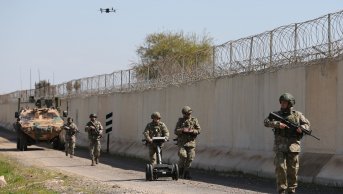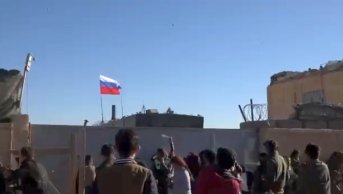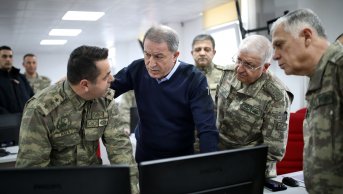Astana Summit can be a New Roadmap for Solution in Syria

Several initiatives have been taken within the last periods to politically solve the Syrian crisis but they have ended up in failure. One of the most important factors which have led to failure has been the incessant war between the armed groups while the political parties have tried to compromise at the table. Secondly, each actor that is somehow related to the Syrian crisis but has limited influence on this matter has been involved in the process whereas the most influential actors such as Iran have been left out of the process from time to time.
Upon the initiative of Turkey, Russia and Iran, new efforts were made in December 2016 for politically solving the Syrian crisis. With the compromise they reached in Moscow, these three states agreed that the Syrian crisis could not be solved by military means and they would cooperate to prepare the conditions for political solution. As a consequence of the compromise in Moscow, a cease fire was declared as of 30 December 2016 and the parties directly involved in the Syrian crisis met in Astana on 23 January 2017 under the guarantee of three countries. No topic different than those addressed in Moscow was concluded in Astana. It is possible to consider that Astana talks directly involve the addressees of the problem in the topics on which the external actors previously compromised in Moscow. Efforts are focused on the cease fire and the opening of dialogue channels as the minimum requirement for peace before passing on to insolvable political issues in Astana process.
Elements making Astana different
The armed groups that are directly parties to the cease fire gathered around the table in Astana rather than political representatives, which is a factor that increases the hopes for cease fire. Considering the external actors, many countries were previously involved in the process. The basic logic is as follows: the more actors are made part of the process, the higher the chance for success is. However, this approach brought the difficulty of finding a common ground for diversifying interests. The adopted approach is in contrast to what was stipulated in Astana. This time, three most influential actors involved in the Syrian crisis come together rather than multilateral talks. According to the new logic, it seems possible that the most influential small-scale group will compromise and the other actors such as the USA, the Gulf States will be gradually involved in the process. Similarly, efforts are focused on the cease fire and the opening of dialogue channels as the minimum requirement for peace without touching upon the insolvable political issues in Astana process. Therefore, it is seen that actions are taken within a narrow framework and efforts are made to widen the circle in time in terms of both the actors involved in the process and the addressed issues. This approach can be said to increase the chance of success.
DAESH and Fateh al-Sham Front (previously called al-Nusra Front) were already excluded from the cease fire and YPG remained outside Astana process upon Turkey’s request. The representatives of Kurdish National Council in Syria participated in the meeting. Syrian opposition was represented by the military groups that are mostly influential on the northern front and are close to Turkey, such as Faylaq al-Sham, al-Sham Front, 1st Coastal Division, 2nd Coastal Division, Sultan Murad Division, Martyrs of Islam Brigade, Fastaqim Kama Umirta, Islamic Military, Hamza Division, Suqour al-Sham Brigade. Syrian Turkmens also attended Astana talks with some political representatives, notably Syrian Turkmen Assembly and an armed group. Some other armed opposition groups either did not recognize Astana talks or announced that they would support from outside despite Turkey’s efforts to convince.
Chance of success in Astana process
Another factor which increases the chance of success of Astana talks is that three most powerful actors, which have the capacity to make the actors in Syria put the compromise into practice, form considerable part of the process. It is possible to say that the regime includes the actors that can fully control the armed groups. Besides its influence over Syrian government, Iran is the most influential actor which directly leads military operations in the field, coordinates with armed groups, leads, arms and finances them. Russia is also the most efficient power to help the regime advance with its air and land forces and this gives it the chance to have influence over the regime. Besides, Iran is also efficient on the ground thanks to the 4th and 5th Army Corps formed upon its guidance in order to balance its influence in the field. Therefore, the regime and its external supporters can control the situation in the field despite some exceptions if they act sincerely. The biggest weakness of this wing is Iran's sincere commitment to political solution and the extreme radical tendency of Iran-backed militia. Syrian regime is mostly inclined to listening to Iran rather than Russia. Putting aside the radical elements, it can also be said that the opposition wing includes the most powerful groups. Turkey is has influence and persuasiveness over the opposition thanks to its geographical position and long-lasting relations. The opposition is aware of the vitality of Turkish support and there are not many supporters they can trust except for Turkey. There is not much doubt about the sincerity of the opposition and its external supporter but the biggest weakness of this wing is that a roof has not been built over all the opposition groups and some of them insist on military solution. This causes the convergence of some opposition groups with al-Nusra Front.
Conflicts started in Idlib after Astana
This situation triggered Idlib-based conflicts after Astana talks. Al-Nusra Front is the actor which objects most seriously to political solution and Astana process. This both draws more reactions from the organization against Turkey and makes the relations with the opposition groups participating in Astana talks more conflicting. A dual division is roughly seen in the conflicts which broke out in Idlib immediately after Astana talks. Nur ad-Din Zengi, Ansar al-Din Front and some other groups which act together under the leadership of al-Nusra Front and are united under the leadership of Tahrir al-Sham on one hand and the opposition united under the leadership of Ahrar al-Sham on the basis of joint actions against al-Nusra on the other hand. Idlib-oriented developments, which are the subject of another study, may lead to the rise of an "Islamic Emirate" under al-Nusra control in the near future.
Putting aside such developments, it is possible to describe Astana talks as a small but successful step taken to resolve the Syrian crisis. It is expected to maintain the cease fire so that political solution could be possible, to build mechanisms which inspect the cease fire, to ensure that humanitarian aid is accessible so that the tension in Syria will be defused and to open the dialogue channels between the regime and the opposition. If these expectations are satisfied, it can be said that Astana process is successful. However, it will be very optimistic to interpret that a political solution is close after Astana talks. The real “chaos” in the solution of the Syrian crisis will be seen concerning the future of Assad and the leading figures of the regime, power sharing, new constitution, powers of the head of state, the future of Ba’ath Party, disarmament of armed opposition groups. No one wants to deal with these seemingly insolvable issues at this phase. The basic logic is to primarily focus on the reconcilable issues and to await easier conditions to solve the problematic questions in the detente. Therefore, it is possible to say that we are away from a real political solution for the time being.
Russia’s constitutional amendment proposals for Syria and Trump’s proposal for safe zone
Immediately after Astana talks, two new developments were witnessed in relation to political solution in Syria. Firstly, the news was released in the press showing that Russia put forward a constitution draft to Syrian opposition in Astana talks. The draft proposed by Russia includes the articles related to changing country’s official name into the Republic of Syria, balancing the authorities of the head of state with those of the parliament, granting the parliament with the authority to appoint to certain critical duties. However, what is interesting for everyone, notably Turkey is the proposed solution model for Syrian Kurds. Even though it was first reflected that federation was proposed to Kurds in the constitution draft, Russian officials denied this allegation and announced that they offered “cultural autonomy”. The constitution draft proposes a model where local administrations will gain strength but Syria’s unitary structure will be maintained. Russian officials adopted a discourse indicating that “the entire Syrian population would decide on federalism in Syria”, which is in parallel with the approach of the regime. It is obvious that federalism will not be accepted if the decision is up to the entire Syrian population. Russia’s “sincere feelings” about Syrian Kurds or federalism will indeed disturb Turkey. However, Russia’s priority in Syria is definitely not the Kurds. The regime and the relations that Russia has improved with Turkey are critical for Russia which is focused on the future of Russian military bases, and it does not want to cross the line and risk them. On the other hand, Russia has historical relations with Kurds in the Middle East and believes that they should have a state. Furthermore, it does not want to lose Kurds and push them completely close to the USA. This situation forces Russia to follow a balance policy. That is why it welcomed PYD representatives together with those of the other opposition groups in Moscow immediately after Astana talks. However, this approach is relatively acceptable for Turkey considering the mentioned limitations. Turkey even put pressure on al-Assad government for long years in order to solve the problems of Syrian Kurds on the basis of equal citizenship.
Meaning of proposed safe zone and risks for Turkey
The proposal that might be “dangerous” for Turkey in terms of Syrian Kurds was put forth again by US President Trump after Astana talks. It was understood that Trump “gave instructions to the relevant institutions to work in order to build safe zones in Syria” as he promised in the campaigns and after the elections. It might initially look positive that the USA supports this idea Turkey has brought forward for long years. Nonetheless, this proposal seems to be problematic under the current conditions and to raise questions for Turkey. Since the main purpose of Turkey’s demand for safe zone was to prevent Syrian civilians from suffering from airstrikes and to stop new migration waves. Furthermore, it was aimed at supporting the efforts of Turkey-backed Syrian opposition to redress military balance against the regime. However, the compromise reached upon Astana talks already foresees a cease fire in Syria. In such an environment, actions are taken by accepting that there will be no airstrikes in the regions outside the control of DAESH and al-Nusra Front. Furthermore, it was now too late for the new migration waves and unfortunately what happened happened. Finally, there are low expectations of intense migration waves given that Aleppo has been reclaimed by the regime. Most importantly, Turkey has already built a de facto safe zone under the initiative of its Euphrates Shield operation. Under these circumstances, Trump’s demand for a safe zone causes the following question to rise: “Does the USA want YPG to gain immunity in its regions?” The opposition controls very small parts on the map of Syria, except for Idlib. DAESH-held regions will already be bombed constantly. Air cover is provided by Russia in the regions under the regime control. The opposition groups have control in two vast areas. The first area is Idlib but it is increasingly going under the control of al-Nusra as mentioned above. This organization has been kept out of the cease fire and new airstrikes will set it as target in the new period. The second vast area is the Euphrates Shield but the no-fly zone request of Turkey which is in cooperation with Russia is not on the agenda for the time being.
US should make a choice
What is left behind is the regions under YPG control in the east of the Euphrates and in Afrin. If the USA provides immunity for these regions on the pretext of building “safe zones”, this will weaken Turkey’s hands in the fight against YPG and its efforts will deepen the current crisis with the USA. Everyone thinks of the experience in northern Iraq and is concerned that the borders of the safe zone may become those of federal states in the future.
Trump’s proposal raised doubts at the beginning and it should be admitted that there are still several uncertain points. Turkey contributed to the formation of a no-fly zone in northern Iraq and it is doubtful how air support will be provided in these regions in Syria without Turkey’s cooperation. Trump and possible cabinet members give positive messages concerning cooperation with Turkey in terms of Syria. However, some more time will be needed for Trump administration to understand that it cannot cooperate with Turkey and YPG at the same time in Syria. What is important is what Trump administration will prefer after understanding this controversy. This preference will determine Turkey-US relations and how YPG-held regions will be shaped in Syria.










